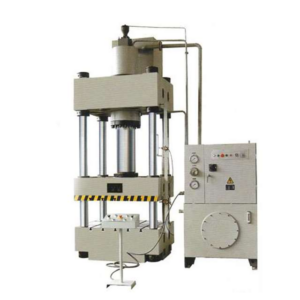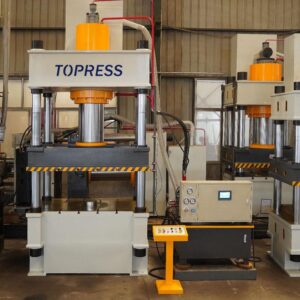En el mundo de la fabricación, la carretilla es una herramienta sencilla pero indispensable. Desde las obras de construcción hasta los jardines, su utilidad es innegable. Sin embargo, detrás de este sencillo aparato se esconde un sofisticado proceso de producción, que depende en gran medida de maquinaria avanzada como las prensas hidráulicas.
Estas máquinas desempeñan un papel crucial en la conformación, formación y ensamblaje de los distintos componentes de la carretilla, lo que garantiza su durabilidad y eficiencia. En este blog, se analizan los detalles de cómo las prensas hidráulicas son fundamentales para la producción de carretillas, destacando sus componentes, principios de funcionamiento y ventajas.

Componentes y principios de funcionamiento de las prensas hidráulicas
Las prensas hidráulicas funcionan según la Ley de Pascal, que establece que la presión aplicada a un fluido confinado se transmite por igual en todas las direcciones. Este principio permite que las prensas hidráulicas ejerzan una fuerza tremenda con precisión. Los componentes clave de una prensa hidráulica incluyen:
Sistema de control: Esto puede ser manual, semiautomático o completamente automático, lo que permite un control preciso sobre las operaciones de la prensa.
Cilindro hidráulico: El corazón de la prensa hidráulica, el cilindro es responsable de generar la fuerza de prensado.
Bomba hidráulica: Este componente bombea fluido hidráulico al cilindro, creando la presión necesaria.
Válvulas: Estos controlan el flujo y la presión del fluido hidráulico.
Marco: La estructura robusta que mantiene unidos los componentes y soporta la fuerza generada.

Principales aplicaciones en la producción de carretillas
Formación de la bandeja de la carretilla
La bandeja de la carretilla, el componente principal que soporta la carga, comienza como una lámina plana de metal. Se utilizan prensas hidráulicas para darles la forma deseada. El proceso implica troquelar, cortar las láminas de metal planas al tamaño y la forma requeridos utilizando una prensa hidráulica y embutir profundamente, donde una prensa hidráulica da forma a las láminas de metal en una bandeja profunda y curva. Este proceso implica embutir el metal en una cavidad de matriz, que le da la forma de la bandeja de la carretilla. El control preciso de la prensa hidráulica garantiza un grosor y una resistencia uniformes en toda la bandeja.
Conformado y punzonado de componentes
Las prensas hidráulicas también son esenciales para dar forma y perforar varios componentes más pequeños de la carretilla, como manijas, soportes y soportes. Los procesos involucrados incluyen el doblado, donde las prensas hidráulicas doblan varillas y placas de metal en ángulos específicos para formar manijas y soportes, y el punzonado, que crea orificios y ranuras en los componentes metálicos para acomodar pernos y tornillos. Esto garantiza que todas las piezas encajen perfectamente durante el ensamblaje. El recorte implica eliminar el exceso de material de las piezas estampadas para lograr la forma y el tamaño finales.
Montaje de la carretilla
El montaje de la carretilla implica la fijación de la bandeja, las asas, las patas y la rueda. Las prensas hidráulicas también desempeñan un papel en esta fase. El remachado es una de esas aplicaciones en las que se utilizan prensas hidráulicas para remachar varios componentes, lo que garantiza una conexión resistente y duradera. El ajuste a presión implica el uso de prensas hidráulicas para encajar los componentes con un ajuste de interferencia ajustado, como por ejemplo, al presionar los cojinetes en las ruedas o los ejes en el bastidor.

Ventajas de utilizar prensas hidráulicas
El uso de prensas hidráulicas en la producción de carretillas ofrece varias ventajas. La precisión es una ventaja importante, ya que las prensas hidráulicas proporcionan un control preciso de la fuerza y el movimiento, lo que garantiza un resultado uniforme y de alta calidad. La eficiencia es otro beneficio, ya que este equipo puede manipular grandes volúmenes de material rápidamente, lo que aumenta la velocidad de producción y reduce el tiempo de inactividad.
La versatilidad también es crucial, ya que estas máquinas pueden realizar diversas tareas, como conformado, plegado, punzonado y ensamblaje, lo que las hace muy versátiles en el proceso de producción. La durabilidad es inherente a la construcción robusta de las prensas hidráulicas, lo que garantiza una confiabilidad a largo plazo y requisitos mínimos de mantenimiento. La rentabilidad se logra automatizando y agilizando los procesos de producción, lo que reduce los costos laborales y el desperdicio de material.
Mantenimiento y solución de problemas
Para mantener un rendimiento óptimo y una larga vida útil de las prensas hidráulicas, es esencial realizar un mantenimiento y una resolución de problemas periódicos. Se deben realizar inspecciones de rutina para verificar si hay fugas, desgaste y daños en el sistema hidráulico. El mantenimiento del fluido implica asegurarse de que el fluido hidráulico esté limpio y en el nivel correcto, reemplazándolo según lo recomendado por el fabricante. Las verificaciones de componentes deben incluir la inspección y el mantenimiento de todos los componentes, incluidos cilindros, bombas, válvulas y sistemas de control. La calibración debe realizarse periódicamente para mantener la precisión y exactitud.

¿Por qué elegirnos?
Elegir el socio adecuado para sus necesidades de fabricación es crucial y aquí le mostramos por qué nuestra empresa se destaca. En primer lugar, contamos con años de experiencia en la industria, perfeccionando nuestras habilidades y conocimientos para proporcionar prensas hidráulicas y equipos relacionados de primer nivel. Además, aprovechamos los últimos avances tecnológicos para garantizar que nuestros equipos sean eficientes, confiables y capaces de cumplir con los más altos estándares de producción.
Además, nuestro compromiso con la calidad es inquebrantable, ya que cumplimos con estrictas medidas de control de calidad para garantizar que cada máquina que entregamos cumpla con los más altos estándares de rendimiento y durabilidad.
Además, nuestro equipo de atención al cliente está siempre listo para ayudarle con cualquier consulta o problema, garantizando un funcionamiento sin problemas y un tiempo de inactividad mínimo. Además de esto, ofrecemos una gama completa de servicios, desde la consulta inicial y la instalación hasta el mantenimiento y soporte continuos, para satisfacer sus necesidades de fabricación. Por último, con una amplia red y presencia global, podemos prestar servicios a clientes en varias regiones, garantizando una entrega y soporte oportunos.
Prensas hidráulicas Industria Futuro
Las prensas hidráulicas son una piedra angular en la producción de carretillas, ya que proporcionan la fuerza, la precisión y la versatilidad necesarias para dar forma, formar y ensamblar diversos componentes. Su papel en el proceso de fabricación garantiza que las carretillas sean duraderas, eficientes y de alta calidad.
A medida que avanza la tecnología, las prensas hidráulicas siguen evolucionando y ofrecen capacidades y eficiencias aún mayores para la producción de carretillas y otros productos. Tanto si es un fabricante que busca optimizar su línea de producción como si es un consumidor curioso acerca de las herramientas que se utilizan para fabricar artículos de uso diario, comprender el papel de esta máquina arroja luz sobre la sofisticación que se esconde detrás de productos aparentemente simples.



